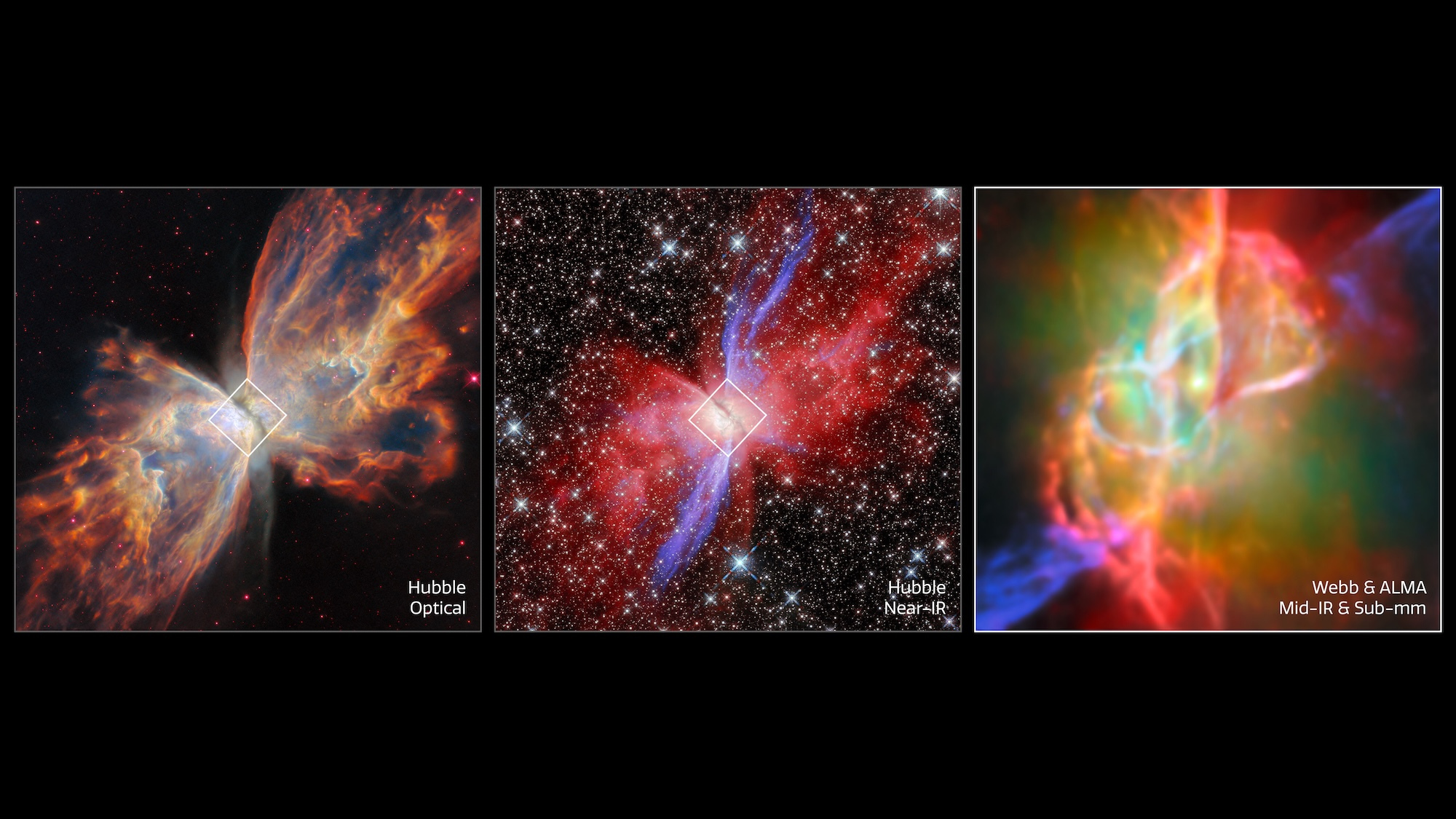Science
Astronomers Uncover Planet-Making Dust in Stunning Butterfly Nebula

Astronomers have made significant strides in understanding the formation of cosmic materials within the planetary nebula NGC 6302, commonly referred to as the Butterfly Nebula. Using the advanced capabilities of the James Webb Space Telescope (JWST), researchers are gaining new insights into this vivid nebula located approximately 3,400 light-years from Earth. Their findings, detailed in the Monthly Notices of the Royal Astronomical Society, enhance knowledge of the ingredients that contribute to rocky planets.
Lead researcher Mikako Matsuura from Cardiff University emphasized the unique observations made possible by JWST. “We were able to see both cool gemstones formed in calm, long-lasting zones and fiery grime created in violent, fast-moving parts of space, all within a single object,” Matsuura stated. This discovery provides a clearer picture of how these essential components of planets are formed.
Understanding Planetary Nebulae
Despite its name, a planetary nebula does not serve as a birthplace for planets. This term originates from centuries past when early telescopes made these nebulae appear round. Subsequent observations revealed that they exhibit various shapes, often formed when a star between 0.8 and eight times the size of our sun sheds its mass at the end of its lifecycle. These nebulae are relatively rare, typically lasting only around 20,000 years.
The Butterfly Nebula, classified as a bipolar nebula, features two sections that extend in opposite directions, resembling butterfly wings. At its center lies a tire-shaped region obscured by gas, which houses the ancient stellar core. This core burns at an astonishing 395,540 degrees Fahrenheit, making it one of the hottest known planetary nebulae in the Milky Way.
JWST’s observations have unveiled a diverse array of minerals and organic materials streaming from the nebula’s jet streams. The latest data reveals a wide spectrum of wavelengths emitted by a dense band of gas known as a torus. Almost 200 spectral lines have been confirmed, each providing insights into the complex mixture of atoms and molecules present in NGC 6302.
Cosmic Dust and Its Origins
The formation of cosmic dust has long been a subject of debate among scientists. With the capabilities of the James Webb Space Telescope, researchers are beginning to establish a clearer understanding of this process. Most cosmic dust appears to have random atomic structures and resembles soot. However, the extreme stellar energy within NGC 6302 allows particles to fuse into more complex materials, including crystalline silicates like quartz and metals such as iron and nickel.
A particularly surprising discovery was the detection of carbon-based molecules known as polycyclic aromatic hydrocarbons (PAHs) within the nebula. Typically found on Earth in sources like car exhaust and wood smoke, this finding may represent the first concrete evidence of PAHs forming within a planetary nebula. This breakthrough could help elucidate the origins of such molecules in space.
While planetary nebulae do not directly create planets, they act as factories producing essential components for carbon-rich planets. Researchers like Matsuura are optimistic that further studies will provide deeper insights into the origins of Earth and the conditions that support life. “This discovery is a big step forward in understanding how the basic materials of planets come together,” Matsuura noted.
As astronomers continue to analyze data from JWST, the Butterfly Nebula stands as a vibrant testament to the intricate processes that shape the cosmos, highlighting the ongoing quest to unravel the mysteries of our universe.
-

 Lifestyle3 months ago
Lifestyle3 months agoLibraries Challenge Rising E-Book Costs Amid Growing Demand
-

 Sports3 months ago
Sports3 months agoTyreek Hill Responds to Tua Tagovailoa’s Comments on Team Dynamics
-

 Sports3 months ago
Sports3 months agoLiverpool Secures Agreement to Sign Young Striker Will Wright
-

 Lifestyle3 months ago
Lifestyle3 months agoSave Your Split Tomatoes: Expert Tips for Gardeners
-

 Lifestyle3 months ago
Lifestyle3 months agoPrincess Beatrice’s Daughter Athena Joins Siblings at London Parade
-

 World3 months ago
World3 months agoWinter Storms Lash New South Wales with Snow, Flood Risks
-

 Science3 months ago
Science3 months agoTrump Administration Moves to Repeal Key Climate Regulation
-

 Business3 months ago
Business3 months agoSoFi Technologies Shares Slip 2% Following Insider Stock Sale
-

 Science3 months ago
Science3 months agoNew Tool Reveals Link Between Horse Coat Condition and Parasites
-

 Science2 months ago
Science2 months agoSan Francisco Hosts Unique Contest to Identify “Performative Males”
-

 Sports3 months ago
Sports3 months agoElon Musk Sculpture Travels From Utah to Yosemite National Park
-

 Science3 months ago
Science3 months agoNew Study Confirms Humans Transported Stonehenge Bluestones









